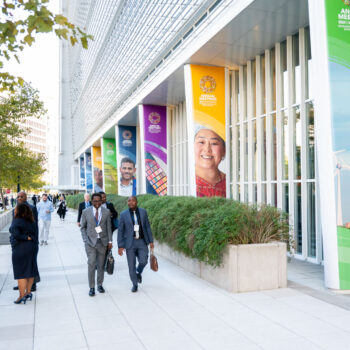Multilateral Development Banks (MDBs), particularly the World Bank, can play a crucial role in bridging the gap between fraught politics, available funds, and what is needed to finance climate action. MDBs’ unique capacity to pool and leverage resources makes them critical institutions to drive ambition – but they need to move faster as part of a wider effort to increase international support. This will be particularly critical as countries seek to agree a New Collective Quantified Goal (NCQG) on climate finance at COP29.
Why MDBs are so crucial: Cost-effective leveraging
The fight against climate change is accelerating, but financial resources to match the urgency remain limited. As the world looks toward the IMF/World Bank Annual Meetings this week, one major question looms: how do we scale up international climate finance quickly and effectively? According to a G20 Roadmap, the answer partly lies in multilateral development banks (MDBs), with the World Bank at the forefront.
MDBs are essential because of their unparalleled ability to leverage financial resources. MDBs have the capacity to attract significant amounts of private investment for every dollar of public capital that governments put in. This leveraging effect is vital when the investment needs for addressing climate change are so high and public finance is so scarce. Climate-related investments, especially in developing countries, can carry perceived risks for private investors. MDBs can help to lower these risks through innovative financial instruments such as guarantees and risk-sharing mechanisms, making projects more attractive to the private sector. This blending of public and private capital is the most cost-effective pathway to increase public climate finance.
MDBs can also provide financing at lower interest rates and with longer repayment periods than commercial lenders, including through concessional lending. This is particularly important for low-income and vulnerable countries that face difficulties accessing capital markets due to higher credit risks. Furthermore, MDBs can drive economies of scale by working across multiple countries and sectors. They can negotiate better terms, secure better financing packages, and deliver larger projects more efficiently than individual countries could alone – including by working with others through country platforms. Whilst they cannot solve every problem and a broader increase in international support will also be needed, there is no pathway to delivery without the MDBs.
What to expect from the upcoming Annual Meetings
As the World Bank/IMF Annual Meetings begin, several key developments are expected, each with potential to enhance or expand MDB lending capacity.
Announced last week, the lowering of the Bank’s equity-to-loan (E/L) ratio to 18% will allow it to extend more credit relative to its equity base. This reform will unlock an additional $3 billion/yr in lending capacity.
Enhanced callable capital—new resources that shareholders commit to provide in case of emergency—could also be a key tool in expanding the World Bank’s capacity. However, the original intent of the Capital Adequacy Reform exercise was to reflect credit for the Bank’s existing callable capital. This is not that – and even credit rating agencies think the Bank could go much further.
A new corporate scorecard is expected to be finalized, providing a framework to hold the World Bank accountable for its sustainable lending. The revamped scorecard will measure real-world outcomes, not just loan amounts, and progress could be used as a hook for shareholders to direct more finance through MDBs.
The official announcement of one or more country lending platforms is imminent. Learning lessons from Just Energy Transition Partnerships (JETPs), these platforms are designed to streamline coordination of climate and nature finance at the national level, ensuring projects are aligned with country priorities, with funds pooled and disbursed efficiently and effectively via a structured dialogue with investors. These platforms could serve as delivery models for developing countries seeking to implement large-scale climate action and the role of MDBs is critical.
More to come: The need for systemic reform
While these reforms are promising, they are not enough. To truly unlock the potential of MDBs, a broader systemic reform of the international financial architecture (IFA) is required. This includes expanding MDB capital through further measures to enhance balance sheets (including full implementation of capital adequacy framework (CAF) reforms). It also includes the need for new resources through general capital increases (GCI), and the use of Special Drawing Rights (SDRs) from the IMF, as well as innovative tax regimes, debt sustainability measures, and macro-prudential reforms. As part of a wider strategy for supporting developing countries, these measures could serve to unblock finance flows, improve delivery mechanisms, and provide the long-term resources needed to scale climate finance to the levels required.
To secure all of that, however, political agreement and long-term sequencing are essential. Without high-level political commitment from shareholders, the necessary reforms will languish. MDB evolution must continue if we are to meet the demands of the climate crisis, and the reforms must go further to secure a pathway for meeting climate goals. The Annual Meetings present an opportunity to push for those transformative changes that can unlock the resources needed to confront climate change at scale, as well as for a better dialogue on where the MDBs can and can’t deliver. No more debating the need for better banks vs. bigger banks – climate change demands both.



